Menu
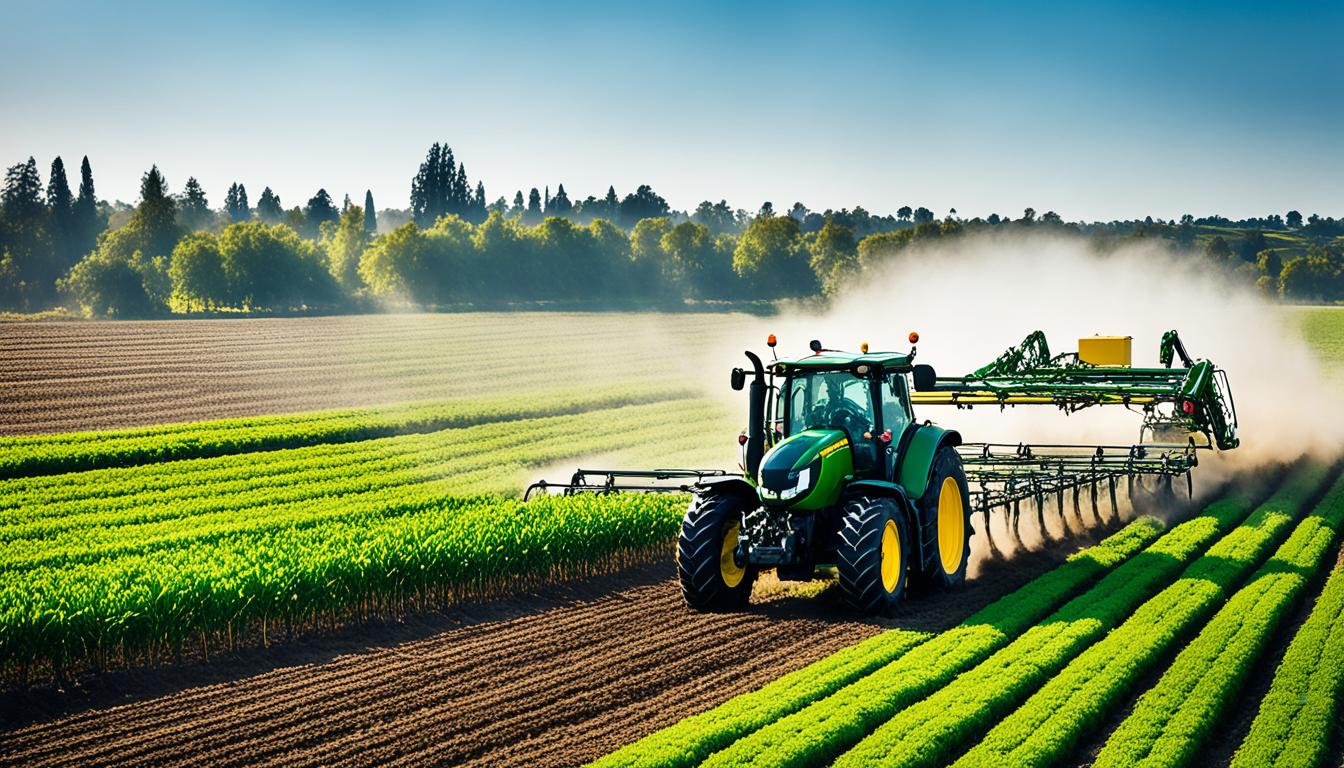
By 2050, the world will need 70% more food due to more people. There is also a big issue as almost 10% of us still go hungry. This makes creating new farming tech very important.
Farming is changing thanks to new tech. Things like precision farming and tall indoor farms are helping. These methods are making farming better for food and the planet.
These new ways of farming are not just ideas. They are happening. They help farmers grow crops better and in ways that help the Earth. Making use of this tech is very important. It will help feed everyone in the future without harming our planet.
By 2050, the world will need 70% more food because of fast population growth. Yet, almost 10% of people worldwide are still hungry. This shows why we need to revolutionise farming. Agri-tech has great potential to change how we grow food. The trends in farming tech show efforts to meet these needs while caring for the planet.
The market for precision farming is set to hit $16.35 billion by 2028. It will grow at a rate of 13.1% a year. This type of farming uses technologies like RTK to map fields precisely. This helps improve soil and its productivity. Such innovations are changing farming for the better, making it more productive and efficient.
Indoor vertical farming is cutting water use by 70% and lowering labour costs. It does this through the use of robots and automation. This type of farming is changing how we grow vegetables. The global greenhouse market makes almost $350 billion worth of vegetables every year thanks to these methods.
Livestock farmers are turning to data-driven technologies to do better. These technologies help improve productivity and take better care of animals. They make farm resources, like water and feed, go further. This helps improve farming practices around the world.
Automation on farms is also making a big difference. It reduces the need for human work and increases harvests. This makes farming more efficient and better for the environment. Also, the market for farm management software is growing fast. It shows a big demand for better ways to manage farms.
The precision agriculture market is set to be worth $43.4 billion by 2025. This forecast highlights the need for farmers to use new technologies. These trends show that farming is changing a lot. The changes point to the key role of innovation in the future of farming.
“The goal is clear: harnessing the power of advanced technology to not only feed a growing population but also to do so in a manner that preserves our planet for future generations.”
As we look for sustainable ways to meet the demand for food, new farming technologies are very important. Precision agriculture, indoor vertical farming, and automation are leading this change. The ongoing drive for innovation is set to transform our farms of the future.
Bee vectoring technologies are a game-changer in farming today. They use bees to carry natural protection to crops. This method is an eco-friendly alternative to chemical sprays.
They benefit the environment by reducing the use of harmful chemicals. They help us to preserve bees, which are vital for growing our food. The use of this tech leads to bigger harvests, less disease in plants, and longer-lasting food.
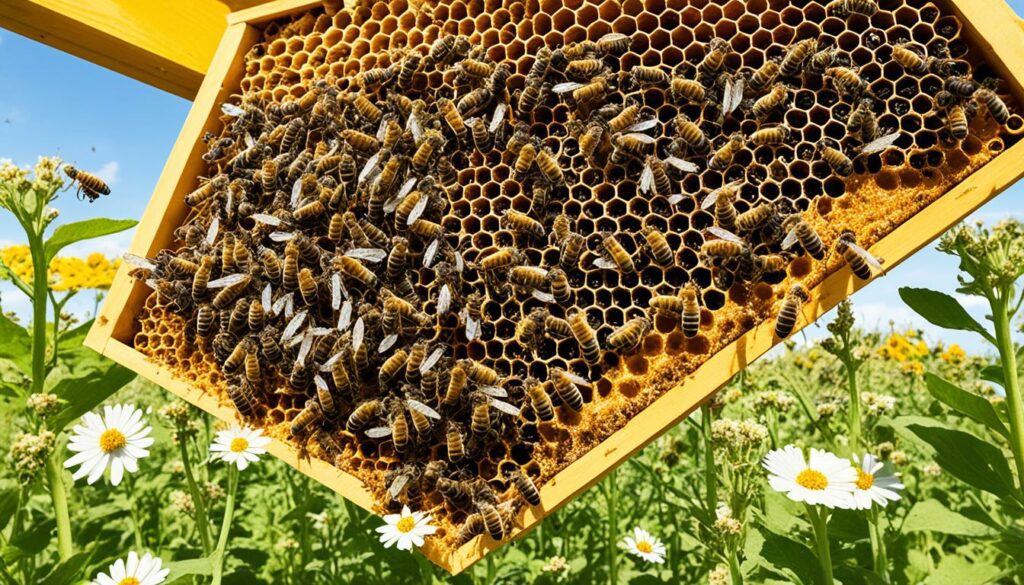
This method takes advantage of bees’ natural behaviour. Bees visit flowers and in return, help spread a natural fungicide. They do this when flying out of their hives and walking through special dispensers.
These dispensers are filled with a special substance. It sticks to the bees’ legs. Then, as the bees visit more flowers, they deliver this natural protection directly where it’s needed. This way is very accurate and doesn’t require big machines or harmful chemicals.
Bee vectoring works well in different types of crops all over the world. It has been successfully used on tomatoes in Spain and blueberries in the Pacific Northwest. In South Africa, a partnership with MBFi is testing its effectiveness against spraying.
This technology can even work with soybeans, which is a huge market that’s expected to get even bigger. Bee vectoring’s success in various crops shows its bright future in farming.
Overall, using bee vectoring is a big step towards more sustainable farming practices.
Precision agriculture is now key in farming, focusing on using resources better. It mainly aims at being efficient with resources. This is important for lasting farm growth.
Efficient resource use is the main goal in precision farming. It’s about getting more from our land without harming the environment. By making choices based on data, every farming step is designed for the best outcome.
This is crucial with a 70% increase in food demand expected by 2050. We must use our resources wisely for farm practices that last.
Precision farming relies on high-tech tools for data collection and decision-making. These tools drive smart farming, including:
By 2028, precision farming could be worth $16.35 billion. It’s growing quickly at 13.1% yearly. This shows how technology can hugely change farming, making it more essential in managing farm resources.
Indoor vertical farming is a new way to grow more food in less space. It uses special techniques and doesn’t need soil. This makes it good for the environment and helps us produce food all year round.
Indoor vertical farming saves a lot of resources. It can use 98 percent less water and needs 99 percent less land than traditional farming. This smart way of growing food can also make farms in the middle of cities. This reduces the pollution that comes from moving food around.
These farms can grow food much quicker. They work all year long, no matter the season. This is a big help as more people are living in cities. It means there will always be enough fresh food close by.
Indoor farming uses special ways to grow plants without soil. Two popular methods are hydroponics and aeroponics. Hydroponics grows plants in water full of nutrients. Aeroponics suspends plants in the air and feeds them with a mist. These methods are very water-efficient and don’t need harmful pesticides. They can also run mostly by themselves, saving money and time.
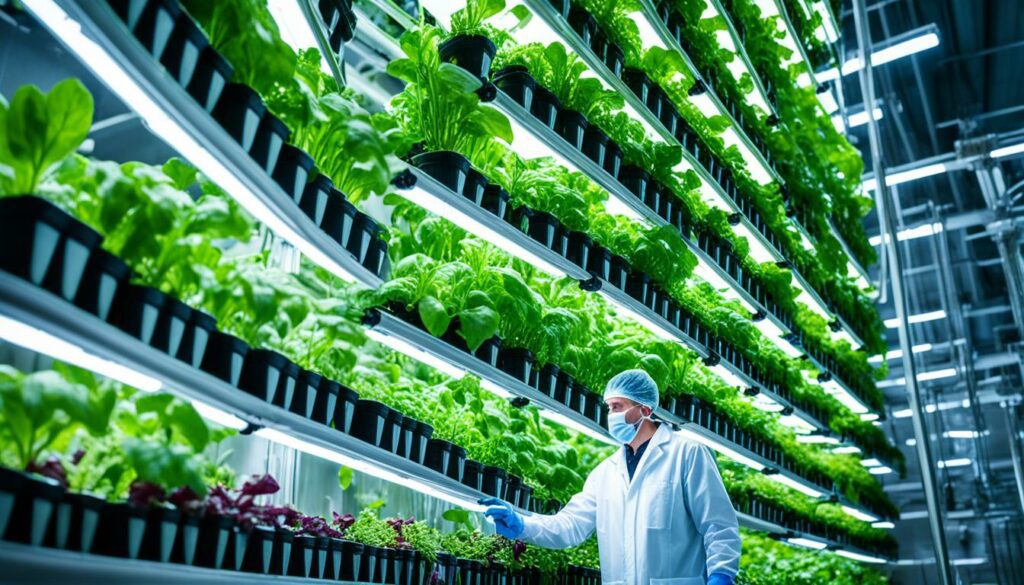
As our world gets more crowded, we need new ways to grow food. Indoor vertical farming is a great answer, especially for cities where land is scarce. By the time 2050 comes, most of us will be living in cities. This farming will be a crucial part of making sure we have enough food without hurting the planet.
| Benefit | Description |
|---|---|
| Water Efficiency | Up to 98% less water usage |
| Land Efficiency | Up to 99% less land requirement |
| Crop Yield | 240 times more efficient through year-round production |
| Pesticide Reduction | Less reliance on pesticides, creating a naturally pest-resistant environment |
| Location Flexibility | Can be constructed in urban areas, rooftops, warehouses |
Data-driven livestock farming is changing the game, making farms more efficient and animal-friendly. About 12% of dairy farms use robots for jobs like milking and feeding now. It’s expected that in the next five years, this will grow to 20%. The move to automated dairy installations is all about boosting efficiency and taking better care of the animals.
Using data helps farmers make better choices. Sensors now track things like milk amount, quality, and the health of animals in real-time. This means farmers can do what’s needed quickly, improving how hard the farm works and looking out for their animals better.
In the U.S., managing livestock is worth over $30 billion every year. This has caught the eye of investors. Companies like Cainthus and Rex Animal Health use smart analytics to help manage animals better.
Genomics and smart sensors help farmers make the most of their animals through thoughtful breeding. For example, sensors let dairy farmers keep track of their cows’ health. This helps increase productivity while keeping animals happier.
But, not everyone is quick to jump on these tech trends. The livestock business has up-and-down cycles and buying these technologies can be very expensive up front. Still, these tech solutions make for happier cows. They let animals live more like they would naturally, in more caring environments.
One cool tech example is using sound waves to treat mastitis. It’s working very well, curing around 70% of cases. It also boosts milk production by 10%. This is good for the animals and the farms’ bottom lines.
The future of farming depends on embracing data-driven insights and smart technologies. As these tools become more common in farming, they will help strike a balance between being productive and being kind to animals.
Laser scarecrows are a new way to stop birds damaging crops. They use a green light to keep birds away. This method came from the University of Rhode Island. It’s a big step forward in protecting crops and helps the environment too.
These scarecrows use a moving green laser to make birds feel unsafe. They work in large areas, up to 600 feet away. Most helpful during key times for crops, they can stop birds from attacking. This new tech focuses on times when crops need the most protection.
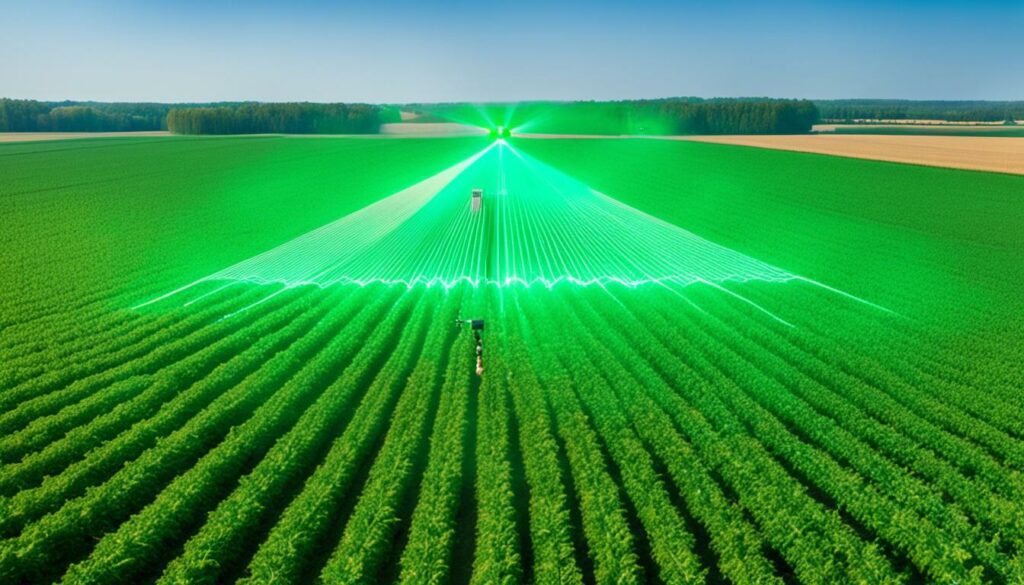
Research shows these scarecrows cut down crop damage by 90%. They save farmers money compared to other methods. Each scarecrow costs between $300 to $500 and stays effective for three weeks. They can cover big fields alone, or work together in busier bird areas.
“The study presented 18 captive flocks of free-flying European starlings with fresh ears of sweetcorn, demonstrating that devices emitting a moving laser beam can significantly reduce crop damage up to 20 meters from the laser device.”
| Method | Effectiveness | Cost | Environmental Impact |
|---|---|---|---|
| Laser Scarecrows | 70%-90% | $300-$500 per unit | Environmentally friendly |
| Human Patrols | Varies | High | Neutral |
| Traditional Scarecrows | Low | Low | Neutral |
| Netting | High | Moderate to High | Neutral |
Laser scarecrows are at the forefront of modern pest control. They help save crops, boost farm output, and support eco-friendly farming. This shows how new tech can improve farming’s future.
The agricultural sector is facing bigger demands due to a growing population. Agricultural automation is key to boosting productivity. This improvement comes from using advanced machines and systems. It helps farmers achieve more harvest and use their workforce better.
Farmers now have many automated tools to choose from. These include automated harvesters, self-driving tractors, and drones. Automated harvesters can pick crops efficiently, saving time and labour. Self-driving tractors use GPS and sensors to work on fields without much help. Drones give a top-down view to check crops and spray them precisely.
Agricultural automation has greatly improved how farmers work. Less manual labour means farmers can focus on more important jobs. This boosts productivity in farming. Working with machines reduces mistakes. This leads to better crop care and higher harvests.
| Machinery | Function | Impact |
|---|---|---|
| Automated Harvesters | Crop harvesting | Increases efficiency, reduces labour time |
| Autonomous Tractors | Field tasks | Minimises human intervention, optimises operations |
| Drones | Crop monitoring | Enhances precision spraying, reduces manual inspection |
It’s expected that by 2028, the precision farming market will hit $16.35 billion. More and more farms will adopt these technologies. Real-time data from smart systems will enhance farming methods. This will create a future where farming is efficient and highly productive, with less work.
Real-Time Kinematic (RTK) technology is at the forefront of precision farming. It delivers 1 cm accuracy, much better than the 2-4 meter accuracy of devices like phones. This precision cuts down on overlaps, saves fuel, and speeds up work.
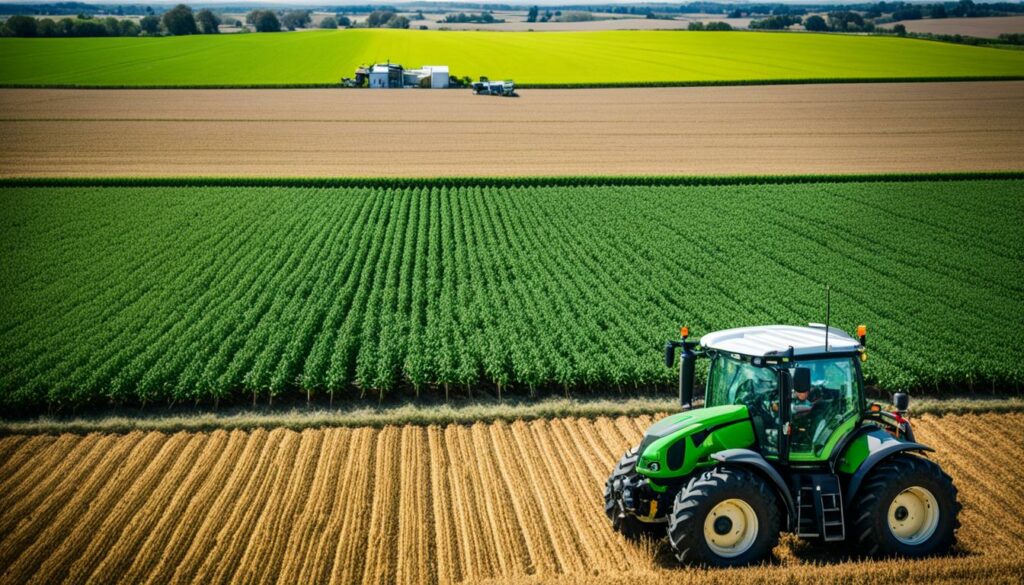
RTK is key to precision farming, making field mapping and vehicle control very accurate. It avoids soil compaction, uses inputs better, and helps farmers make smart choices. These benefits boost farming productivity and save resources.
FieldBee’s RTK and autosteer tools play a big role in making work more accurate and efficient. Huida Tech is also a leader, offering very precise positioning with its navigation system and drone. Such technology makes farm work much more efficient.
RTK technology improves how machinery works on the farm. Auto-steering means machines can make straighter rows and space plants evenly. This makes planting more efficient and reduces how tired the operator gets.
| Aspect | Traditional GNSS | RTK Technology |
|---|---|---|
| Accuracy | 2-4 meters | 1 cm |
| Operational Efficiency | Moderate | High |
| Cost Saving | Low | High |
| Resource Optimisation | Limited | Enhanced |
Using RTK in precision farming is great for many reasons. It stops machinery from overlapping. It makes machines work better on the ground, and saves resources like insecticides and fertilisers. Plus, it lets farms work longer, even at night.
The world of farming is changing fast, thanks to new technology. With more people and a big demand for food, the industry is reshaping. It aims to grow in a way that’s good for the planet and makes more food.
A big step forward is the minichromosome technology for improving crops. It boosts good qualities like surviving droughts and fighting off pests. This means we can use fewer harmful chemicals on our plants.
There’s also a rise in software that helps manage farms. It’s expected to grow 11.2% by 2026. This tech links up buying, moving products, and handling money in one place. It helps farms run better and make decisions using data.
More advanced farming tech is coming up. Precision farming, which uses super accurate mapping, will become very popular. By 2028, it’s predicted to hit a market value of $16.35 billion. This tech makes fields healthier and more productive.
Vertical farming is another exciting area. It uses less water and space to grow food in cities. Methods like hydroponics cut water use a lot. This kind of farming will help us grow more food where there’s not much room.
In [livestock farming, we’re finding new ways to keep animals healthy. Health conditions like bovine mastitis cost a lot each year. But, new tech and treatments are aiming to cut these costs and help the cows better.
There are even laser scarecrows now, showing how tech is changing old farming problems. They cut down on birds that eat crops. It’s a high-tech way to protect crops without hurting the environment.
The future of farming looks bright with all this new tech. It’s all about making farming better for the planet and producing more food. The journey towards an innovative and sustainable agricultural future continues.
Minichromosome technology is a big step in genetic engineering for crops. It lets us make crops better without changing their main genetics. This method is a new chapter in growing food in a way that’s better for the environment.

Minichromosomes are like extra, specially designed chromosomes in a plant. Chromatin Inc. first showed how to make them. This method doesn’t mess with a plant’s core genetics, leaving them as they were. This is why minichromosome technology is so exciting for making crops stronger and healthier.
Using minichromosomes can help crops grow more and fight off pests. Normal ways of changing plants can sometimes be risky. But, by only adding new genes, minichromosomes avoid these problems. They might also mean less use of harmful chemicals.
Imagine superplants that can survive droughts and keep bugs away. With many more people set to be on Earth, we need smart ways to grow more food. Minichromosome technology could play a big part in this.
| Crops | Advancements | Impact |
|---|---|---|
| Soybeans | High Omega 3 oils, increased yields | Enhanced nutritional value and output efficiency |
| Papayas | Resistance to ringspot virus | Stability and improved productivity in Hawaii |
| Potatoes | Blight resistance | Reduction in chemical fungicide usage by up to 90% |
Looking to the future, new ways of working together in agriculture, like with Monsanto Co. and Syngenta, are exciting. These partnerships will help make the most of minichromosome technology.
Farm management software shows how SaaS is growing in agriculture. It gives tools to help farmers run their farms better. This tech automates many farm tasks. It links purchasing, supply chains, and finances. The benefits of these platforms are huge. They bring everything together digitally for farmers. This makes managing farms easier.
The best farm software has lots of advanced features. They make farms more efficient. These platforms keep track of everything on the farm. They watch crop plans, use of resources, and money. You can do things like:
This software helps farms in many ways. It makes things run better. It saves water, fertilisers, and energy by using data. This helps with ESG goals by being greener. It also boosts how much food farms can grow. This is crucial with less resources and climate change. This industry feeds billions and makes trillions of food every year. So, using such software is very important now.
| Feature | Benefits |
|---|---|
| Real-time data analytics | Informed decision-making, enhanced crop health, tailored soil management |
| Inventory management | Optimised stock levels, streamlined procurement, reduced waste |
| Precision farming tools | Efficient resource usage, improved crop yields, minimal ecological footprint |
| Forecasting models | Accurate yield predictions, better planning, risk mitigation |
The future of farm software looks bright. SaaS is set to become key in farming. As these tools get better, they’ll keep changing how farms work. They want to make farming sustainable and productive for the future.
Effective water management in agriculture is crucial today. Over 40% of the world faces water scarcity. New farming technology has come about to tackle this. Such methods use water wisely and support sustainable farming. This is critical as natural disasters are more often linked to water issues.

Agriculture is moving from old flood irrigation to advanced methods. Currently, most fields are watered with flood irrigation. But now, techniques like centre pivot systems and drip irrigation are gaining ground. Although these are expensive, they save a lot of water. They are important for the future of farming, where water use needs to be efficient.
Smart water management is great for the planet and the economy. It reduces waste and cuts costs. This approach also helps to save the environment by using water more effectively. Rainwater harvesting and greywater use are two techniques that are growing in popularity. They reduce the need for fresh water and ease the load on cities. Also, advanced water treatment helps keep water clean.
To sum up, modern farming and water management are changing the game. They help use water better in agriculture. This is crucial as agriculture uses 70% of the world’s fresh water. These new methods are key to a sustainable future, saving water and protecting our planet.
The world’s population is set to hit 10 billion by 2050. This means farmers need to grow food more efficiently while taking care of the land. They’re turning to high-tech tools like AI and data analytics. These tools help them see exactly how their fields are doing. Thanks to this, they can use fertilisers better and keep pests at bay. It all leads to bigger harvests.
Latest tools such as FarmBeats and Agrocares are changing the game. They give farmers tips in real time using the power of the cloud. This makes managing soil and crops much more effective. As almost 10% of the world still goes hungry, keeping an eye on crop health is vital. The right soil tests help keep plants healthy.
The market for smart farming tools will top $16.35 billion by 2028. This is because we’re relying more on hi-tech methods to look after soil and crops. Tools like Real-Time Kinematic (RTK) give super accurate insights into soil health. This leads to better farming all around.
| Technology | Function |
|---|---|
| FarmBeats | Real-time, cloud-based data for actionable insights |
| Agrocares | Comprehensive farm management solutions |
| RTK | Centimetre-level accuracy for soil health management |
By 2050, we’ll need 70% more food. This makes using smart farming tech crucial. It not only boosts harvests but protects the future of farming. This tech will help meet the world’s growing hunger needs in a sustainable way.
As we enter an era of big agricultural changes, the role of agritech is crucial. It is key in reshaping the world of farming. Our growing world needs more food but must protect the environment.
Agritech boosts how much food we produce while cutting down on water and chemicals. It makes farms safer places to work. For example, Jiva is a platform that helps farmers tackle daily challenges using modern tools.
However, our goal of farming in an environmentally friendly way is still a work in progress. Some farming methods can be good for the planet, like healthier soil and saving water. But, we must be careful not to harm the land with too many chemicals and single-crop fields.
Using agritech wisely and managing resources well is the solution. This way, we can grow more food without hurting our planet. The success story of farming in the U.S. shows how powerful agritech can be. With the rise of new technologies like genetically improved crops, farming’s future looks bright. It will be more efficient and better for nature, thanks to ongoing innovation.
Bee vectoring tech offers a green option against chemical pesticides. It uses bees to deliver protection to crops naturally. This method keeps pollinators safe and boosts crop yields and soil health.
Precision agriculture makes use of data, remote sensors, and automation tools. It helps farmers control factors like moisture and soil health precisely. This leads to healthier crops and more output.
Indoor farming overcomes limits of space and saves resources like water and energy. It also cuts down on labour costs through automation. This method uses hydroponics or aeroponics to grow plants indoors.
Data-driven tech in livestock farming consists of automated dairy systems and new treatments. These technologies help manage farms better and care for animals more effectively. This leads to increased output and better animal welfare.
Laser scarecrows work by using green light to scare off birds. They are highly effective in reducing the damage birds can do to crops. This method is eco-friendly and needs little human input.
Farm automation features machines like harvesters, self-driving tractors, and drones. These tools make farm work more efficient, with fewer mistakes and increased yield. They change how farms use labour.
RTK gives ultra-precision for field mapping and controlling vehicles. It supports controlled traffic farming, which helps soil stay healthy by reducing compaction. This kind of farming leads to better crop growth.
Innovations include minichromosome tech, smart farm software, exact irrigation, and advanced crop oversight. They’re designed to make farming more sustainable and productive.
Minichromosome tech boosts crop features like resisting drought and pests. It does this without changing the natural genetic makeup of the crop. This approach helps with biodiversity and avoids health issues linked to GMOs.
Top farm management software, like FarmERP, merges buying, supply chain, and finances. It gives farmers digital tools to watch over and run their farms more efficiently.
New irrigation methods, including exact irrigation and recycling water, help use water smarter. This aids in preserving the environment while still growing crops.
Crop and soil monitors use AI to give insights in real-time. This makes it easier to apply nutrients just where they’re needed and fight pests before they can harm the crops. It keeps crops and soil healthier.